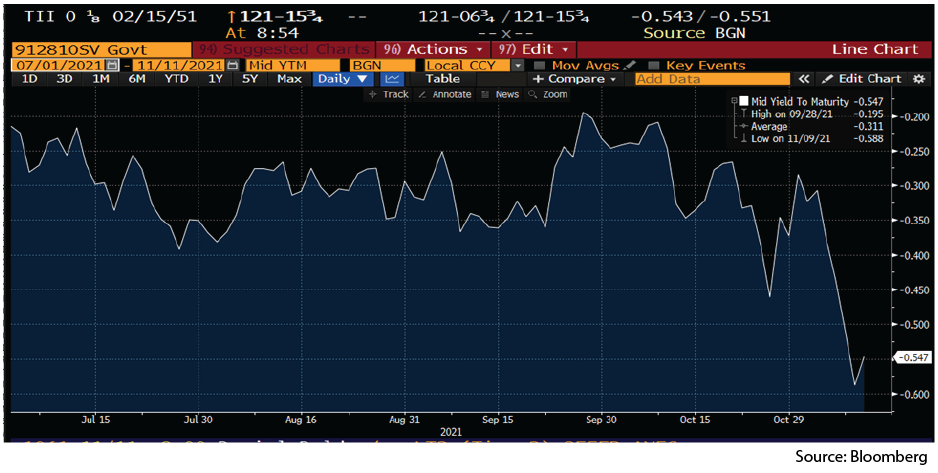The real yield is the yield that has been adjusted for inflation. The TIPS yield is a real yield. Thus in the current environment, the TIPS market pays a rate of return less than inflation.
The question one should be asking is why is this happening?
PRICE OF TIPS
To start we have to first understand how TIPS are priced. To price the current TIPS one has to make an assumption about what future inflation will be.
The equation to calculate the 30 Year TIPS value is the following:
Yield to Maturity (YTM) 30 Year Treasury note - Expected inflation rate for 30 years = YTM 30 Year TIPS.
Since two of the items are observable in the marketplace we can write the equation as the following:
YTM 30 Year Treasury note - YTM 30 Year TIPS = Expected inflation rate for 30 years.
Adding the values from the marketplace into the equation we have the following:
(30 Year Treasury) 1.91% - (30 Year TIPS) -0.55% = 2.46% (Expected Inflation rate for 30 years)
Thus at present, the market believes the U.S. will have 2.46% inflation per year for the next 30 years.
INFLATION
The U.S. Federal Reserve has stated that their goal is to have a 2% inflation target over the long-run. As shown above, the expected inflation rate in the marketplace is 2.46% which is slightly more than the target the Federal Reserve has stated. Using 2% inflation expectation instead of the 2.46%, the yield to maturity for the 30 year TIPS would increase to -0.09%. While this helps improve the yield, it does not appear that this is the driver of the negative yields for TIPS.
30-YEAR TREASURY
If, in a rational market, the Treasury market is fairly priced, one should be able to lend money to the U.S. Treasury Department at a rate above zero in real terms. One then has to conclude that the 30-Year Treasury bond is overvalued, given the real yield is negative. To see what the Treasury market should yield, we can do some math from above. If the expected inflation rate continues to be 2.46% and the 30 year TIPS yield 1%, similar to what the yield was before 2020, then the 30-year Treasury note should yield 3.46%.
It would appear that the U.S. Treasury note is trading below the expected inflation rate and this is resulting in the TIPS market having a negative yield.
TREASURY MARKET
The U.S. Treasury market is influenced by a number of factors besides inflation. At the present moment, the current inflation is relatively high at 6.2%. In order for this inflation to come back down towards the 2% target, either the supply chain bottlenecks need to be resolved, or the Federal Reserve will need to raise rates to reduce growth and inflation in the U.S. economy.
The 30-year Treasury note is influenced by long-term interest rate policies and long-term growth rates. If we fall into the camp that the Federal Reserve will need to raise interest rates as a way to reduce growth and inflation in the U.S. economy, then one could see if the Treasury market is signaling this is coming. Keeping the same math as before, and using the 30 year Treasury rate of 1.91%, expected inflation would have to fall to 0.91% for the TIPS market to yield 1%. This looks to be too low for expected long-term inflation, given the target over the long-term is 2% for the Federal Reserve. Thus, it does not appear that the Treasury market’s current yield is entirely a result of expected interest rate policy. Rather it would appear that the negative yields in the TIPS market are a direct result of Treasury yields being too low by an abundance of demand for longer-dated Treasuries. Even if one assumes that the Federal Reserve will increase interest rates to quell the higher inflation that exists, the rates do not appear to be correct. Rather, longer-term interest rates appear to need to reprice at materially higher yield if the Federal Reserve’s targets will be met over the longer-term and the Treasury market is rationally priced.
As this shows, we continue to believe the U.S. Treasury market is overvalued and have positioned our portfolios to be short duration to outperform when the market reprices itself. More specifically, we feel that the longer parts of the Treasury market are most extremely priced and have expressed our shorter duration by being underweight the longer end of the curve.
Download Article


